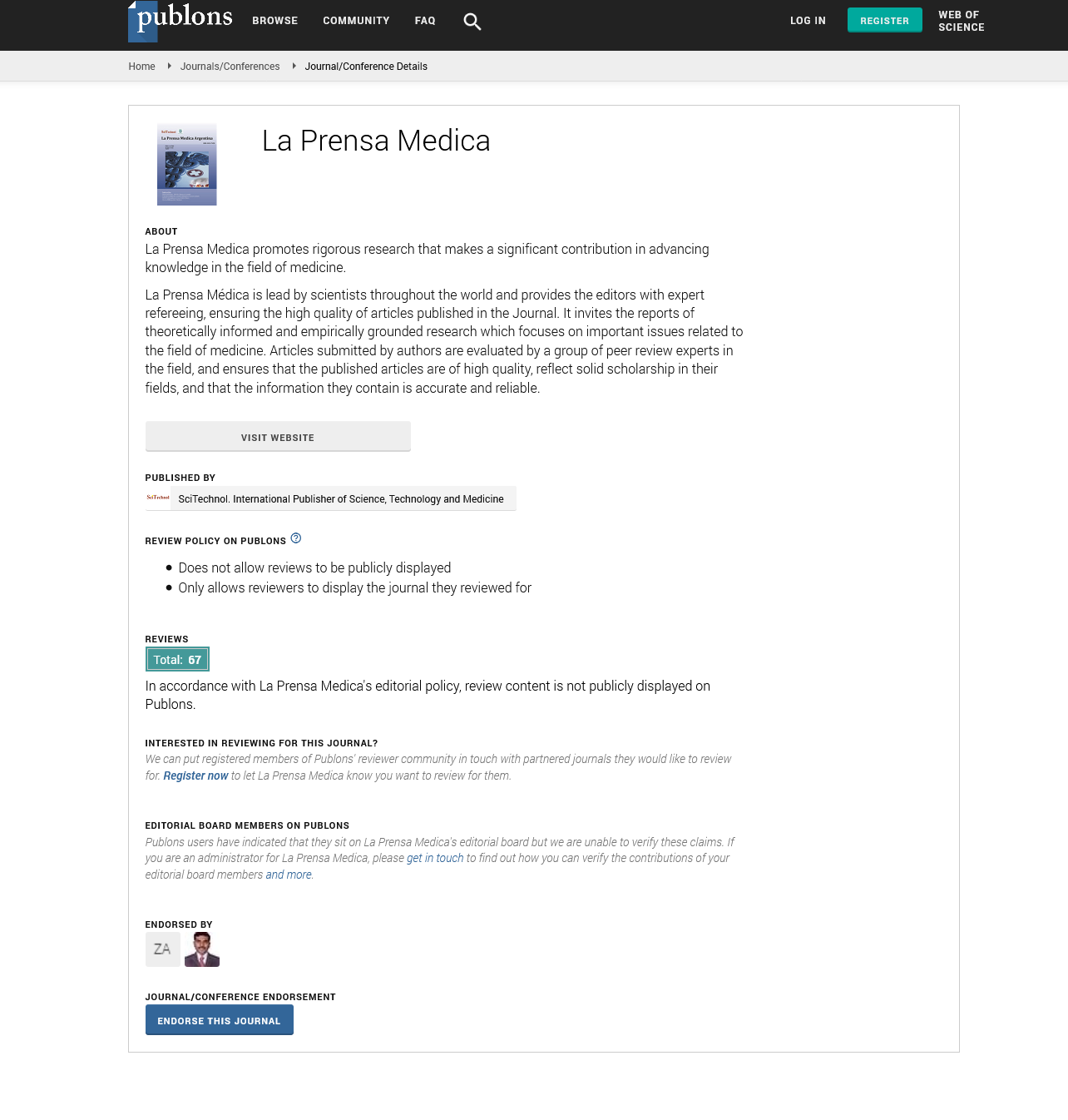Perspective, La Prensa Medica Vol: 108 Issue: 1
Thyroid Infection the Second Most Commonly Perceived Endocrinopathy
Janning Loges *
Department of Cancer, University Medical Center Mannheim, Mannheim, Germany
*Corresponding Author: Janning Loges
Department of Cancer, University Medical Center Mannheim, Mannheim, Germany
E-mail:yjqiao@bucm.edu.cn
Received date:01 February, 2022, Manuscript No. LPMA-22-57671;
Editor assigned date: 03 February, 2022, PreQC No. LPMA-22-57671 (PQ);
Reviewed date: 17 February, 2022, QC No LPMA-22-57671;
Revised date: 22 February, 2022, Manuscript No. LPMA-22-57671 (R);
Published date: 28 February, 2022, DOI: 10.4172/0032-745X.1000128
Citation: Loges J (2022) Thyroid Infection the Second Most Commonly Perceived Endocrinopathy. La Prensa Medic 108:2.
Keywords: Forensic Science ,Forensic Pharmacology ,Forensic Toxicology, Environmental Forensics, Clinical Chemistry
Description
The capacity of Lactobacillus plantarum strain 8RA-3 to discharge neurohormones arginine vasopressin and oxytocin when developed on strong and in fluid supplement media was laid out. An expansion in the centralization of discharged chemicals was found to rely upon term of the development of a L. plantarum 8PA-3 suspension culture. The capacity to discharge oxytocin was ineffectively communicated in Escherichia coli M17 and Staphylococcus aureus K4 and was not found in Micrococcus luteus C6. The expansion of these chemicals and their receptor adversaries to the fluid supplement medium didn't influence the development pace of L. plantarum 8PA-3 cells. The aftereffects of morphological and phylogenetic examination of Coleochlamys apoda strain ACSSI 377, disconnected from the natural soil outside on the outer layer of a sandy substrate in the North of Russia are introduced. Morphology is portrayed, including the presence of mature S-molded cells regular of the species С. oleifera, and development of synzoospores was accounted for interestingly for the species. Investigation of the 18S rRNA and rbcL quality arrangements showed that the strain had a place with the animal varieties Coleochlamys apoda this is the main finding of this species found in the Russian region affirmed by sub-atomic hereditary methods. The presence of clades comprising of crude clones on the 18S rRNA quality tree meant that the request being deficiently examined and of the possibilities of identification and depiction of its new individuals.
Nature and circulation
Nature and circulation of Coleochlamys and of the sister sort microthamnion were investigated in view of the writing date and the writers' perceptions. Individuals from the sort Coleochlamys favor cold natural surroundings and happen inside a restricted geographic reach, as opposed to microthamnion, which has been over and over found in different areas.
The eukaryotic algal variety Coleochlamys was initially portrayed by Korshikov in view of the strain secluded from a Ukrainian Sphagnum marsh and named Coleochlamys apoda Korshikov. The accompanying morphological elements were recorded among its attributes: club-formed cells, straight or bended, for the most part of unpredictable, profoundly factor shape, extensively adjusted toward one side and tightened at the other. The chloroplast is parietal, with one pyrenoids. Propagation by zoospores shaped by protoplast division. The piece of the protoplast situated at the tight finish of the cell isn't changed over into a zoospore, however stays at its place, and forms into another vegetative cell inside the old envelope. The zoospores are bare, at first practically round, then, at that point, prolonged, tightened at the front end, with two flagella and a shame; they are delivered through a profound sidelong break in the phone divider at the highest point of the zoosporangium. Four different species were hence remembered for the variety which contrasted in the cell size and shape and in the chloroplast type. Further modification of the class utilizing atomic phylogenetic examination of five strains recognized as Coleochlamys spp. uncovered just two obviously separated species: the sort species C. apoda and C. oleifera.
Strain Seclusion and Development
The exploration subject was a strain from the QUA-11 working assortment, which was separated from an organic surface covering at the outer layer of a sand quarry. The quarry was laid out at fluvioglacial stores in the focal piece of the Murmansk b oblast; in the Khibini Mountains lower regions, in the Belaya Stream valley. The strain was stored. The strain was become on the 3N BBM agar medium in a climatostat. Morphology and life pattern of strain ACSSI 377 were examined by light microscopy utilizing magnifying instruments of the Joint Utilize Center, Organization of Physicochemical and Natural Issues in Soil Science, Russian Foundation of Sciences. The outcomes were recorded utilizing computerized shading cameras ProgRes Jenoptik Carl Zeiss MRc 5. The perception was done for 1.5 weeks to 4 months. Zoosporangia arrangement and zoospore discharge were invigorated utilizing the adjusted strategy by Andreeva. For the reason, the alga from a 4-week fluid culture was moved onto two variations of BBM agar medium, with a triple measure of nitrogen and glucose and without both nitrogen and glucose. Following two days, the alga was moved into a drop of refined water for minuscule perception. DNA was detached from the biomass utilizing the D Neasy Plant Smaller than expected Pack as indicated by the producer's convention. Enhancement was done utilizing the screen blend HS PCR combination. The preliminaries and intensification conditions for the qualities are recorded. The objective PCR items were recognized by electrophoresis in 1% agarose gel. Further amplicon purging from the gel was done. Sequencing was done at evrogen.
 Spanish
Spanish  Chinese
Chinese  Russian
Russian  German
German  French
French  Japanese
Japanese  Portuguese
Portuguese  Hindi
Hindi 

